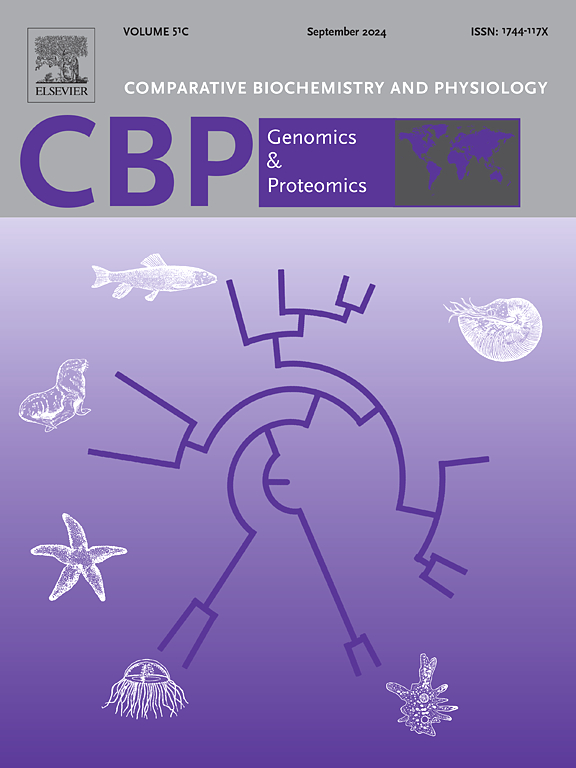Comparative analysis of different Phyllostachys species on gut microbiome and fecal metabolome in giant pandas (Ailuropoda melanoleuca)
IF 2.2
2区 生物学
Q4 BIOCHEMISTRY & MOLECULAR BIOLOGY
Comparative Biochemistry and Physiology D-Genomics & Proteomics
Pub Date : 2025-05-07
DOI:10.1016/j.cbd.2025.101529
引用次数: 0
Abstract
The influences of different bamboo species on the microbiome and metabolome of giant pandas (Ailuropoda melanoleuca) remain understudied. The aim of this study was to investigate the effects of different Phyllostachys species on the gut microbial communities and fecal metabolite profiles in giant pandas. Metagenome and metabolome were performed on the feces of giant pandas fed with different Phyllostachys species (P. edulis, P. iridescens, P. glauca, and P. violascens). The results of metagenome showed that dietary with P. glauca could notably decrease the microbial Shannon index. The relative abundances of both Cellulosilyticum and Pseudomonas were enhanced after dietary with P. iridescens, suggesting P. iridescens could enhance the cellulose-degrading function in giant pandas. However, dietary with P. glauca or P. violascens could increase the relative abundances of certain pathogenic bacteria (Escherichia, Shigella, and Klebsiella). Metabolomics analysis further revealed that all experimental groups exhibited notably elevated levels of fecal flavonoids and fatty acids. In addition, the correlation analysis showed that certain nutrients of bamboo leaves (mainly crude protein and Cu) were significantly correlated with several differential gut bacteria and fecal metabolites. Based on the present results, P. iridescens might be a substitute for the routinely used Phyllostachys species (P. edulis) in the captive management of giant pandas. The results have revealed that bamboo species is an important factor affecting the gut microbiota and fecal metabolites in giant pandas. Our results could provide important information about bamboo species-induced alterations on the microbiome and metabolome in giant pandas.

不同毛竹属物种对大熊猫肠道微生物组和粪便代谢组的比较分析
不同竹种对大熊猫微生物组和代谢组的影响尚不清楚。本研究旨在探讨不同毛竹种类对大熊猫肠道微生物群落和粪便代谢物谱的影响。对饲养不同毛竹种类(毛竹、鸢尾、青花和堇菜)的大熊猫粪便进行宏基因组学和代谢组学分析。宏基因组分析结果表明,饲料中添加青孢假单胞菌可显著降低微生物Shannon指数。饲料中添加虹彩假单胞菌后,纤维素胞菌和假单胞菌的相对丰度均有所提高,表明虹彩假单胞菌可以增强大熊猫体内纤维素的降解功能。然而,饲粮中添加青光假单胞菌或紫色假单胞菌可增加某些致病菌(埃希氏菌、志贺氏菌和克雷伯氏菌)的相对丰度。代谢组学分析进一步显示,所有实验组的粪便类黄酮和脂肪酸水平均显著升高。此外,相关分析表明,竹叶的某些营养成分(主要是粗蛋白质和铜)与几种肠道差异菌群和粪便代谢物呈显著相关。基于目前的研究结果,虹彩瓢虫可能是大熊猫圈养管理中常规使用的毛竹属(P. edulis)的替代品。结果表明,竹子种类是影响大熊猫肠道菌群和粪便代谢物的重要因素。本研究结果可为研究竹子对大熊猫体内微生物组和代谢组的影响提供重要信息。
本文章由计算机程序翻译,如有差异,请以英文原文为准。
求助全文
约1分钟内获得全文
求助全文
来源期刊
CiteScore
5.10
自引率
3.30%
发文量
69
审稿时长
33 days
期刊介绍:
Comparative Biochemistry & Physiology (CBP) publishes papers in comparative, environmental and evolutionary physiology.
Part D: Genomics and Proteomics (CBPD), focuses on “omics” approaches to physiology, including comparative and functional genomics, metagenomics, transcriptomics, proteomics, metabolomics, and lipidomics. Most studies employ “omics” and/or system biology to test specific hypotheses about molecular and biochemical mechanisms underlying physiological responses to the environment. We encourage papers that address fundamental questions in comparative physiology and biochemistry rather than studies with a focus that is purely technical, methodological or descriptive in nature.

 求助内容:
求助内容: 应助结果提醒方式:
应助结果提醒方式:


